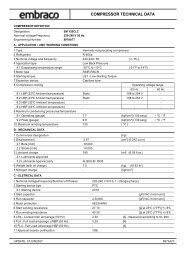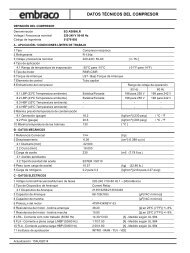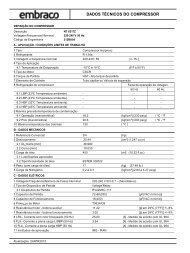Compressor Handbook - Embraco
Compressor Handbook - Embraco
Compressor Handbook - Embraco
You also want an ePaper? Increase the reach of your titles
YUMPU automatically turns print PDFs into web optimized ePapers that Google loves.
COMPRESSORS<br />
HANDBOOK<br />
Chapter<br />
RUNNING DATA AND COMPRESSOR CHECKING PROCEDURES<br />
5. Check the electric motor according to the procedure described in section 7.5.1.<br />
6. Check the ohmic resistance of the stator run and start windings according to the procedure<br />
described in section 7.5.2.<br />
7. Disconnect one of the two cables of the starting capacitor.<br />
8. Check the start and run capacitors according to the procedure described in section 7.5.3.<br />
9. Check the continuity of the cables disconnected from the 2 and 5 terminals of the starting relay.<br />
If from all above checks, no problem was found, there is no clogging in the expansion device,<br />
and the system does not yet run correctly, replace the starting relay, excluding possible mistakes<br />
of opening and closing of the contacts (pick-up and drop-out currents) that can not be found with<br />
above checks.<br />
If the compressor does not yet run correctly, it must be replaced due to internal defects.<br />
7.4.10 Standard versions CSIR and CSIR BOX NT and NJ Series with current<br />
electromagnetic relay<br />
(Refer to electric diagrams CSIR represented on Figure 17, page 28)<br />
(Refer to electric diagrams CSIR BOX represented on Figure 18, page 28)<br />
PLEASE NOTE: The contacts of the starting relay are normally open.<br />
Verify with a voltmeter the presence of the correct net voltage on the terminals 3 and 5 of the<br />
starting relay. If there is insufficient voltage, the thermostat is defective due to open contacts,<br />
connections, or there is a break in the cables.<br />
Disconnect the other electric components, if present (motor fan, gear-motor, etc.), interrupt the<br />
voltage to the circuit at the supply line, and carry out the following operations and checks:<br />
1. Disconnect all connections on terminal 3 of the starting relay.<br />
2. Keeping the start relay in the same vertical position as assembled on the hermetic terminal<br />
(do not incline or overturn), carry out the following continuity checks:<br />
3. Check the continuity between the terminals 3 and 4 of the starting relay. If there is no continuity,<br />
the coil is interrupted and the relay must be replaced.<br />
4. Check the continuity between the terminals 1 and 2 of the starting relay. If there is continuity,<br />
the contact is closed and the relay must be replaced.<br />
5. Check the protector continuity between points 1 and 3. If there is no continuity, the protector<br />
can be:<br />
defective<br />
tripped; then repeat the check after about 10 minutes.<br />
6. Check the electric motor according to the procedure described in section. 7.5.1.<br />
7. Check the ohmic resistance of the stator start and run windings according to the procedure<br />
described in section 7.5.2.<br />
8. Check the start capacitor according to the procedure indicated in section 7.5.3.<br />
9. Check the continuity of the cables disconnected from terminal 3 of the start relay.<br />
If from all above checks, no problem was found, there is no clogging in the expansion device,<br />
and the system does not yet run correctly, replace the starting relay, excluding possible mistakes<br />
of opening and closing of the contacts (pick-up and drop-out currents) that can not be found with<br />
Doc. Code Emission Revision Date Page<br />
MP01E 2000-04 0 20-02 93 - 98

















